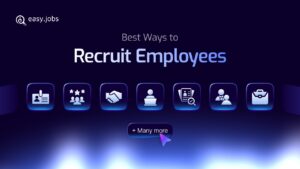Employee well-being has become a cornerstone of organizational success. As companies strive to foster a healthy and productive work environment, Employee Assistance Programs (EAPs) are essential. In this guide, let us explore what EAPs are, their features, types of EAPs, their advantages, etc. You can also learn how to create and measure the success of these programs within your organization.

What Are Employee Assistance Programs?
Employee Assistance Programs (EAP) are comprehensive and confidential support services provided by organizations. Employers assist employees facing personal or work-related challenges that may impact their well-being and job performance. You can think of it as a lifeline for employees navigating the complexities of life, offering assistance in areas such as mental health, financial concerns, substance abuse, legal issues, and more.
EAPs are designed to be proactive, addressing issues before they escalate and negatively impact both the employee and the organization. By providing resources and support, employers aim to create a workplace prioritizing mental health and employee satisfaction, ultimately boosting overall productivity and morale.
Features Of A Well-Implemented EAP
A successful Employee Assistance Program is characterized by specific features that distinguish it as a valuable resource for employees. Here are some key features of a well-implemented EAP. Let us have a look below.
✅ Confidentiality: Employees need to feel secure when reaching out for assistance. Confidentiality is very important in ensuring individuals can openly discuss their concerns without fear of judgment or repercussions.
✅ Comprehensive Services: An effective EAP should cover various issues, including mental health, financial advice, legal guidance, and substance abuse support. The more comprehensive the program, the better it can address the diverse needs of the workforce.
✅ Accessibility: Easy access to EAP services is crucial. Whether through an online platform, hotline, or in-person counseling, the program should be readily available to all employees, regardless of their location or working arrangements.
✅ Cultural Sensitivity: A well-tailored EAP considers the diverse backgrounds and cultures within the workforce. Cultural sensitivity ensures that support services are inclusive and relevant to everyone, fostering a sense of belonging.
✅ Proactive Outreach: Instead of waiting for employees to seek help, a proactive EAP initiates outreach programs and awareness campaigns, reducing the stigma associated with seeking assistance and encouraging early intervention.
Types Of Employee Assistance Programs
Employee Assistance Programs come in various forms, each catering to organizational needs and employee demographics. Understanding the types of EAPs can help organizations choose the most suitable option. Here are some main types of Employee Assistance Programs that you can think of for your organization. Have a look below.
Internal Employee Assistance Programs
Developed and managed within the organization, Internal Employee Assistance Programs are directly integrated into the company’s structure. They often have dedicated staff, such as counselors and psychologists, who work exclusively for the organization.
External Employee Assistance Programs
These programs are outsourced to third-party service providers. External Employee Assistance Programs offer a wider range of specialized services, as they leverage a network of professionals and resources. This type of EAP is particularly beneficial for smaller organizations that may need more resources to establish an in-house program.
Hybrid Employee Assistance Programs
Combining elements of both internal and external EAPs, hybrid programs offer flexibility. They may utilize in-house resources for certain services while outsourcing others. This hybrid approach allows organizations to tailor the program to their specific needs.
Management-Sponsored Employee Assistance Programs
Management-sponsored EAPs guide employees toward well-being with personalized counseling, financial guidance, and career support, reinforcing a workplace culture that values both professional and personal growth. In these programs, proactive management involvement ensures a comprehensive approach to employee welfare.
How To Choose an EAP for Your Organization
Not every EAP is necessary or right for every organization. Choosing the right EAP for your organization requires careful consideration of several factors. Here is a guide to help you make an informed decision for selecting an Employee Assistance Program for your organization. Have a look below.
Assess Employee Needs
Conduct surveys or focus groups to identify the specific challenges and needs of your workforce. Understanding the issues your employees face will guide you in choosing an EAP that addresses those concerns effectively.
Evaluate Program Options
Research available EAP providers and carefully evaluate their offerings. Consider factors such as the range of services, accessibility, confidentiality policies, and cultural sensitivity.
Consider Program Flexibility
Opt for an EAP that can adapt to the changing needs of your organization. A flexible program can accommodate growth, address emerging issues, and adjust services based on employee feedback.
Review Provider Reputation
Look for EAP providers with a solid reputation for delivering effective and reliable services. Client testimonials, case studies, and industry reviews can offer valuable insights into a provider’s track record.
Budgetary Considerations
While employee well-being is priceless, it’s essential to consider the financial aspect. Compare the costs of different EAP options, ensuring that the chosen program aligns with your budgetary constraints.
Advantages Of Employee Assistance Programs

Implementing an EAP can yield a multitude of benefits for employees and organizations. Let us explore some of the key advantages below.
Improved Employee Well-being
By providing support for personal and work-related challenges, EAPs contribute to enhanced employee well-being. This leads to reduced stress, increased job satisfaction, and a more positive work environment.
Increased Productivity
When employees receive timely assistance for personal issues, it prevents these challenges from affecting their job performance. A healthier, happier workforce is inherently more productive, contributing to overall organizational success.
Enhanced Employee Retention
Organizations that prioritize employee well-being through EAPs are likely to experience higher retention rates. Employees feel valued when their employer invests in their mental and emotional health, fostering loyalty and commitment to the company.
Cost Savings
Addressing mental health and personal challenges early can prevent more significant issues from arising. EAPs contribute to cost savings by reducing absenteeism, turnover, and the potential for expensive medical claims.
Positive Organizational Culture
EAPs play a vital role in shaping a positive organizational culture that values its employees. When workers feel supported, they are more likely to engage with their work, collaborate with colleagues, and contribute to a healthy workplace culture.
How To Create Employee Assistance Programs
Creating and offering an EAP requires a strategic approach to ensure its effectiveness. Below are some steps to establish a successful program within your organization.
Conduct A Needs Assessment
Before designing your EAP, you need to identify the specific needs and challenges faced by your employees. This can be done through surveys, focus groups, or confidential interviews to gather insights into the issues affecting your workforce.
Define Program Objectives
You need to clearly outline the goals of your EAP. Whether it is improving mental health, addressing work-related stress, or providing financial guidance, defining objectives helps shape the program’s structure and focus.
Select Appropriate Services
Based on the needs assessment, you can choose services that align with the identified challenges. This may include counseling services, legal advice, financial planning, or workshops on stress management.
Ensure Accessibility
You need to make the EAP easily accessible to all employees. This may involve creating an online platform, setting up a confidential hotline, or establishing physical counseling spaces within the workplace.
Communicate Effectively
Launching an EAP requires effective communication to ensure employees are aware of the program and feel comfortable utilizing its services. You can employ various channels, such as emails, posters, and intranet announcements, to spread the word.
Train Managers and Supervisors
You can equip managers and supervisors with the knowledge and skills to identify signs of employee distress and effectively communicate the availability of the EAP. Their support is crucial in creating a culture that encourages employees to seek assistance.
Monitor and Evaluate
You should regularly assess the effectiveness of your EAP by gathering feedback from employees and reviewing program utilization data. You can use this information to make necessary adjustments and improvements.
How To Measure Success Of Employee Assistance Programs
Measuring the success of an Employee Assistance Program involves assessing its impact on both individual employees and the organization as a whole. You can consider the following metrics to gauge the effectiveness of your program.
🎯 Utilization Rates: You can track the number of employees using EAP services over time. Increasing utilization rates may indicate growing awareness and acceptance of the program.
🎯 Employee Feedback: You can collect feedback from employees who have utilized EAP services. This qualitative data can provide valuable insights into the perceived effectiveness and areas for improvement.
🎯 Absenteeism and Turnover Rates: You can monitor absenteeism and turnover rates before and after implementing the EAP. A reduction in these metrics suggests that the program is positively influencing employee retention and attendance.
🎯 Work Performance: You can evaluate changes in individual and team performance metrics. Improved work performance, increased productivity, and higher job satisfaction can be indicators of a successful EAP.
🎯 Healthcare Costs: You can examine healthcare costs related to mental health and stress-related conditions. A decrease in these costs can be attributed to the preventive and supportive nature of the EAP.
🎯 Benchmark Against Industry Standards: You can compare your EAP metrics with industry benchmarks to gain a broader perspective on its effectiveness. This can help identify areas where your program excels and areas that may need improvement.
Ready To Implement EAPs In Your Organization
Nowadays, prioritizing employee well-being is no longer optional, it is a strategic imperative. Employee Assistance Programs provide a proactive and holistic approach to addressing the challenges that employees face, fostering a culture of support and resilience.
Do you think this article is helpful? Share your thoughts in the comment section. For more career-related articles, subscribe to our blog. Also, join us on our Facebook community to interact with more people.






